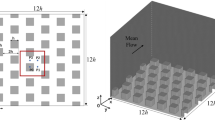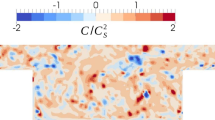Abstract
Further to our previous large-eddy simulation (LES) of flow over a staggered array of uniform cubes, a simulation of flow over random urban-like obstacles is presented. To gain a deeper insight into the effects of randomness in the obstacle topology, the current results, e.g. spatially-averaged mean velocity, Reynolds stresses, turbulence kinetic energy and dispersive stresses, are compared with our previous LES data and direct numerical simulation data of flow over uniform cubes. Significantly different features in the turbulence statistics are observed within and immediately above the canopy, although there are some similarities in the spatially-averaged statistics. It is also found that the relatively high pressures on the tallest buildings generate contributions to the total surface drag that are far in excess of their proportionate frontal area within the array. Details of the turbulence characteristics (like the stress anisotropy) are compared with those in regular roughness arrays and attempts to find some generality in the turbulence statistics within the canopy region are discussed.
Similar content being viewed by others
References
Castro IP, Cheng H, Reynolds R (2006) Turbulence over urban-type roughness: decutions from with tunnel measurements. Boundary-layer Meteorol 118: 109–131
Cheng H, Castro IP (2002) Near wall flow over urban-like roughness. Boundary-Layer Meteorol 104: 229–259
Choi K-S, Lumley JL (2001) The return to isotropy of homogeneous turbulence. J Fluid Mech 436: 59–84
Choudhury D, Kim SE, Makarov BP, Carey C (2004) Improved numerical methods for CFD solutions on unstructured meshes. ERCOFTAC Bull 62: 13–18
Coceal O, Thomas TG, Castro IP, Belcher SE (2006) Mean flow and turbulence statistics over groups of urban-like cubical obstacles. Boundary-Layer Meteorol 121: 491–519
Coceal O, Thomas TG, Belcher SE (2007) Spatial variablity of flow statistics within regular building arrays. Boundary-Layer Meteorol 125: 537–552
Coceal O, Dobre A, Thomas TG, Belcher SE (2007b) Structure of turbulent flow over regular arrays of cubical roughness. J Fluid Mech 589: 375–409
Erm LP, Joubert PN (1991) Low-Reynolds-number turbulent boundary layers. J Fluid Mech 230: 1–44
Hanna SR, Tehranian S, Carissimo B, Macdonald RW, Lohner R (2002) Comparisons of model simulations with observations of mean flow and turbulence within simple obstacle arrays. Atmos Environ 36: 5067–5079
Hayden P, Mapurisa T, Robins AG (2007) Spanwise variation of drag on roughness elements in a nominally two-dimensional boundary layer. Paper presented at PHYSMOD2007, University of Orleans, France, August 2007
Kanda M (2006) Large-Eddy simulations of the effects of surface geometry of building arrays on turbulent organised structures. Boundary-Layer Meteorol 118: 151–168
Kanda M, Moriwaki R, Kasamatsu F (2004) Large-Eddy simulation of turbulent organized structures within and above explicitly resolved cube arrays. Boundary-Layer Meteorol 112: 343–368
Kastner-Kline P, Rotach MW (2004) Mean flow and turbulence characteristics in an urban roughness sublayer. Boundary-layer Meteorol 111: 55–84
Lumley JL (1978) Computational modelling of turbulent flows. Adv Appl Mech 18: 123–126
Meinders ER, Hanjalić K (1999) Vortex structure and heat transfer in turbulent flow over a wall-mounted matrix of cubes. Int J Heat Fluid Flow 20: 255–267
Moeng C-H (1984) A large-Eddy simulation model for the study of planetary boundary layer turbulence. J Atmos Sci 41: 2052–2062
Moreau S, Mendonca F, Qazi O, Prosser D, Laurence D (2004) Influence of turbulence modelling on airfoil unsteady simulations of broadband noise sources. AIAA J 2005–2916
Peric M (2004) Flow simulation using control volume of arbitrary polyhedral shape. ERCOFTAC Bull 62: 25–29
Shaw RH, Schumann U (1992) Large Eddy simulation of turbulent flow above and within a forest. Boundary-Layer Meteorol 61: 47–64
Smalley RJ, Leonardi S, Antonia RA, Djenidi L, Orlandi P (2002) Reynolds stress anisotropy of turbulent rough wall layers. Exp Fluids 33: 31–37
Stoesser T, Mathey F, Frohlich J, Rodi W (2003) LES of flow over multiple cubes. ERCOFTAC Bulletin No. 56
Xie Z-T, Castro IP (2006) LES and RANS for turbulent flow over arrays of wall-mounted cubes. Flow Turbul Combust 76(3): 291–312
Xie Z-T, Castro IP (2008) Efficient generation of inflow conditions for Large Eddy Simulation of street-scale flows. Flow Turbul Combust (in press). doi:10.1007/s10494-008-9151-5
Yoshizawa A (1986) Statistical theory for compressible turbulent shear flows, with the application to subgrid scale modelling. Phys Fluids 29: 2152–2164
Author information
Authors and Affiliations
Corresponding author
Rights and permissions
About this article
Cite this article
Xie, ZT., Coceal, O. & Castro, I.P. Large-Eddy Simulation of Flows over Random Urban-like Obstacles. Boundary-Layer Meteorol 129, 1–23 (2008). https://doi.org/10.1007/s10546-008-9290-1
Received:
Accepted:
Published:
Issue Date:
DOI: https://doi.org/10.1007/s10546-008-9290-1




